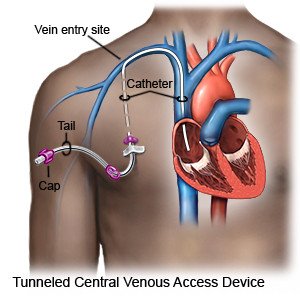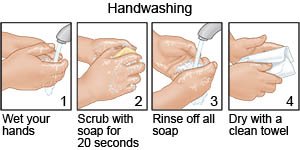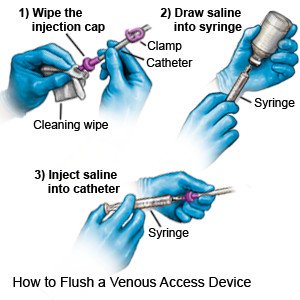How to Care for your Implanted Venous Access Port
Medically reviewed by Drugs.com. Last updated on Aug 4, 2025.
An implanted venous access port is a device used to give treatments and take blood. It may also be called a central venous access device (CVAD). The port is a small container that is placed under your skin, usually in your upper chest. A port can also be placed in your arm or abdomen. The port is attached to a catheter that enters a large vein.
 |
DISCHARGE INSTRUCTIONS:
Call your local emergency number (911 in the US) if:
- You have a headache, blurred vision, and feel confused.
- You have pain in your arm, neck, shoulder, or chest.
- You have trouble breathing that is getting worse over time.
Seek care immediately if:
- Blood soaks through your bandage.
- You hear a bubbling noise when your port is flushed.
- The skin over or around your port breaks open.
- Your heart is jumping or fluttering.
Call your doctor if:
- You have a fever.
- You run out of supplies to care for your skin or port.
- Your port site is red, swollen, or draining pus.
- Your port site turns cold, changes color, or you cannot feel it.
- The veins in your neck or chest bulge.
- You have trouble using your port.
- You have questions or concerns about your condition or care.
Prevent an infection:
- Wash your hands often. Use soap and water. Clean your hands before and after you care for your port. Remind everyone who cares for your port to wash their hands.

- Wear clean medical gloves when you care for your port. Do not touch or handle your port unless you need to care for it.
- Clean the skin around your port every day. Ask your healthcare provider what to use to clean your skin.
- Check your skin for infection every day. Look for redness, swelling, or fluid oozing from the port site.
Medicines:
- Topical medicine may be needed to numb your skin before your port is accessed with a needle. Ask your healthcare provider if and when you should use the medicine.
- Take your medicine as directed. Contact your healthcare provider if you think your medicine is not helping or if you have side effects. Tell your provider if you are allergic to any medicine. Keep a list of the medicines, vitamins, and herbs you take. Include the amounts, and when and why you take them. Bring the list or the pill bottles to follow-up visits. Carry your medicine list with you in case of an emergency.
How to access your port:
Your healthcare provider will show you or a family member how to access your port with a needle. Never try to use your port without proper training. To access your port:
- Gather your supplies. If you have a cough, wear a mask while you prepare and access your port.
- Attach tubing to the needle, if needed. The tubing has a clamp that must stay closed when not in use. You will attach a syringe that contains saline to the tubing. Open the clamp and slowly push saline through the tubing and needle. Then close the clamp to remove air from the tubing before you access your port. Leave the syringe attached to the tubing.
- Clean your port site and the skin around it. Ask your healthcare provider what solution to use. Clean your skin for 90 seconds or as directed. Allow the cleaner to dry completely. Do not blow on the site to dry the area.
- Apply topical medicine to numb the port area, if needed. Use the numbing medicine as directed. The more your port is used, the less it will hurt.
- With one hand, feel for the edges of your port. Use this hand to stretch the skin across your port, to help hold the port in place. With your other hand, insert the needle through your skin and into the center of the port. Push the needle in until you hit the back wall of the port. When the needle is in place, open the tubing clamp, and slowly pull back on the syringe. If blood flows back into the tubing and syringe, the needle is in the proper place. If you do not see blood, you will need to change the position of the needle. Close the clamp on the tubing. Ask your healthcare provider how to throw away the blood-filled syringe correctly.
- Cover the site with a gauze bandage while the needle is in place, if directed. This keeps air, dirt, and germs from entering the port. Ask your healthcare provider how often you should change the bandage if you leave the needle in place.
When to flush your port:
Flush your port with saline (salt water) before, after, and between medicines and treatments. Flush your port with heparin (a blood thinner) between each port use. Your port also needs to be flushed with heparin every 4 weeks when it is not being used regularly. You will use a syringe to push a small amount of saline or heparin into the port and catheter. Flush your port to keep the catheter from getting blocked and to prevent medicines from mixing in the tubing.
 |
How to give medicines through your port:
Your healthcare provider will show you or a family member how to give medicines or liquids through your port. Medicines and treatments enter your port through tubing attached to the needle.
How to remove the needle from your port:
Wash your hands and put on clean medical gloves. Flush your port as directed. Remove the needle. Ask how to dispose of your needles if you do not have a needle container. You may need to cover your port site for a short time after you remove the needle.
Implanted venous access information card:
Your healthcare provider will give you a card with information about your port type. Keep this information in a safe place that is easy to find.
Activity:
When your port is not being used, you can do your usual daily activities. You will be able to bathe, shower, or swim.
Follow up with your doctor as directed:
Write down your questions so you remember to ask them during your visits.
© Copyright Merative 2025 Information is for End User's use only and may not be sold, redistributed or otherwise used for commercial purposes.
The above information is an educational aid only. It is not intended as medical advice for individual conditions or treatments. Talk to your doctor, nurse or pharmacist before following any medical regimen to see if it is safe and effective for you.
Further information
Always consult your healthcare provider to ensure the information displayed on this page applies to your personal circumstances.
